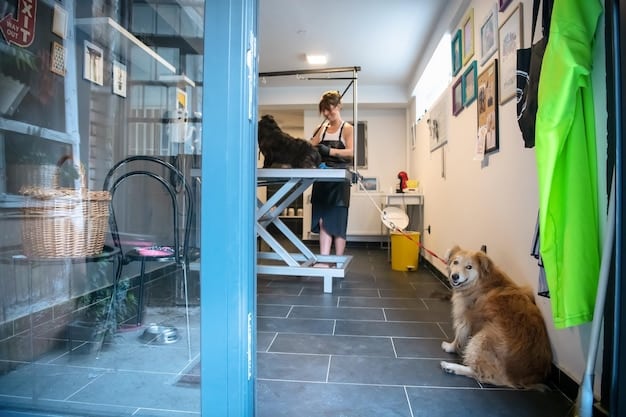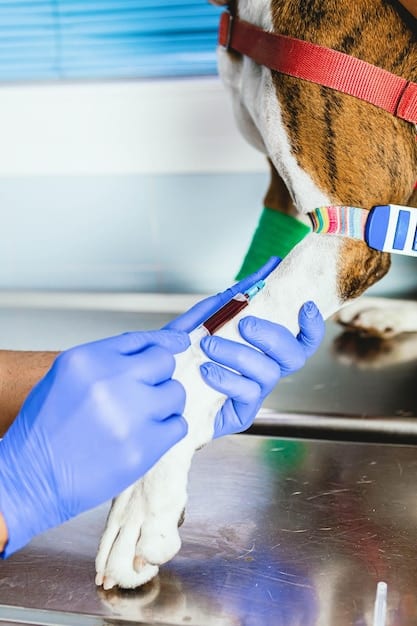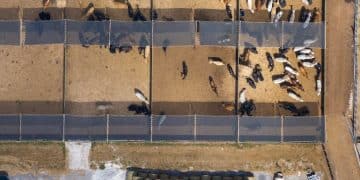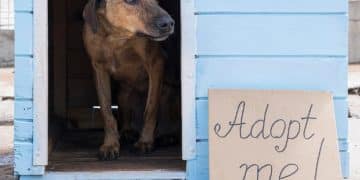Is Your Local Animal Shelter Ready? Winter Pet Surrender Increase Prep

Local animal shelters are bracing for a projected 15% increase in pet surrenders this winter; preparation is vital to ensure they can continue providing care and finding homes for animals in need during this challenging time.
Are local animal shelters prepared for the expected surge in pet surrenders this winter? With a projected 15% increase, it’s crucial to understand the challenges and preparations needed to ensure the well-being of animals in need. Let’s delve into how local animal shelters are navigating this critical period.
Understanding the Looming Winter Pet Surrender Crisis
As winter approaches, many local animal shelters are anticipating a significant rise in pet surrenders. This concerning trend necessitates a proactive approach to mitigate the potential strain on resources and ensure that these shelters can continue providing adequate care for the animals they house.
Understanding the factors behind this increase is crucial for both shelters and the community. Economic hardships, seasonal allergies, and changes in living situations all contribute to the rise in surrenders, requiring shelters to adapt their strategies and outreach efforts.
Economic Challenges and Pet Ownership
Financial instability is a major driver of pet surrenders, especially during the colder months when household expenses tend to rise. Many families face difficult decisions regarding their pets’ care when budgets become tight.
Seasonal Allergies and Pet Surrenders
Although less discussed than economic conditions, seasonal allergies can also contribute to pet surrenders. Some individuals may find their allergies exacerbated during winter, leading them to consider relinquishing their pets.
Here are some key factors contributing to the expected surge:
- Increased Financial Strain: Winter often brings higher heating bills and other seasonal expenses, making it difficult for some families to afford pet care.
- Housing Instability: Changes in living situations, such as evictions or moves, can force pet owners to surrender their animals.
- Seasonal Affective Disorder (SAD): While not a direct cause, SAD can impact pet owners’ ability to care for their animals.
By recognizing these underlying causes, shelters and communities can work together to provide support and resources to struggling pet owners, potentially reducing the number of animals surrendered. Addressing these concerns proactively can help ensure that pets remain in loving homes throughout the winter months.
Assessing Your Local Shelter’s Current Capacity
Before the anticipated surge in pet surrenders hits, it’s imperative for local animal shelters to assess their current capacity. This evaluation should cover several key areas to identify potential weaknesses and areas for improvement.
Understanding the shelter’s limitations and strengths will allow for targeted preparations. This might involve increasing staffing, improving facilities, or enhancing outreach efforts to the community.

Evaluating Physical Space and Resources
The physical space of a shelter is a critical factor in its capacity to handle an influx of animals. Overcrowding can lead to increased stress and disease transmission among the animals.
Staffing Levels and Volunteer Support
Sufficient staffing is essential for providing adequate care, including feeding, cleaning, and medical attention. Volunteers can significantly augment the staff’s efforts, but their availability may fluctuate.
Key areas to consider when assessing shelter capacity include:
- Kennel Availability: Determine the maximum number of animals the shelter can comfortably house without overcrowding.
- Medical Facilities: Evaluate the capacity for treating sick or injured animals, including quarantine areas.
- Food and Supplies: Ensure an adequate inventory of food, bedding, and other essential supplies.
A thorough assessment of these factors will enable shelters to identify potential bottlenecks and develop strategies to mitigate them. By carefully evaluating their current capacity, shelters can better prepare for the challenges ahead and continue to provide a safe and caring environment for animals in need.
Bolstering Resources: Fundraising and Donations
Securing additional funding and increasing donations are vital steps in preparing local animal shelters for the expected rise in pet surrenders. These resources enable shelters to expand their capacity, enhance medical care, and provide essential supplies.
Effective fundraising and donation campaigns can make a significant difference in a shelter’s ability to cope with increased demand. By engaging the community and highlighting the urgent need for support, shelters can mobilize resources and ensure they are well-equipped to handle the surge.
Leveraging Community Support for Fundraising
Community involvement is crucial for successful fundraising efforts. Shelters should explore partnerships with local businesses, schools, and community organizations to broaden their reach and generate more donations.
Maximizing the Impact of Donations
Shelters can optimize the impact of donations through efficient resource management and strategic allocation of funds. This includes prioritizing essential supplies, such as food and medical equipment, and investing in facility improvements.
Strategies for increasing donations and funding include:
- Online Fundraising Campaigns: Utilize platforms like GoFundMe or Facebook to solicit donations.
- Local Business Partnerships: Collaborate with businesses to host fundraising events or donate a portion of sales.
- Donation Drives: Organize drives to collect much-needed supplies like food, blankets, and toys.
By tapping into community support and implementing effective fundraising strategies, shelters can secure the financial resources necessary to navigate the winter months successfully. These efforts will ensure that they can continue to provide a high level of care for the animals in their charge.
Enhancing Medical Care Capabilities
With an increase in pet surrenders, local animal shelters must ensure that their medical care capabilities are robust and able to handle the additional strain. Adequate medical facilities and personnel are crucial for addressing the health needs of incoming animals.
Enhancing medical care not only improves the well-being of the animals but also reduces the risk of disease outbreaks within the shelter. By investing in medical infrastructure and training, shelters can provide timely and effective treatment, enhancing their overall capacity to care for animals in need.

Upgrading Medical Facilities and Equipment
Investing in modern medical equipment and improving facilities can significantly enhance a shelter’s ability to diagnose and treat medical conditions. This includes having access to diagnostic tools, surgical facilities, and quarantine areas.
Ensuring Sufficient Veterinary Staff and Training
Having enough qualified veterinary staff is essential for providing timely and effective medical care. Shelters should ensure they have a sufficient number of veterinarians, veterinary technicians, and trained support staff.
Steps to improve medical care capabilities include:
- Establishing a Quarantine Protocol: Incoming animals should be quarantined to prevent the spread of infectious diseases.
- Vaccination and Deworming Programs: Implement comprehensive vaccination and deworming programs for all new arrivals.
- Partnerships with Local Veterinarians: Forge partnerships with local veterinary clinics to provide specialized care and support.
By prioritizing medical care and investing in necessary resources, shelters can improve the health outcomes for animals in their care and reduce the burden on their overall operations. Strengthening medical capabilities is a key component of being prepared for the expected surge in pet surrenders.
Optimizing Adoption and Foster Programs
Improving adoption and foster programs is a proactive step local animal shelters can take to prepare for an increase in pet surrenders. These programs provide a vital lifeline for animals, offering them temporary or permanent homes and relieving the burden on shelter resources.
Effective adoption and foster programs not only reduce overcrowding in shelters but also provide animals with a higher quality of life in a home environment. By streamlining the adoption process and expanding the network of foster families, shelters can increase the chances of finding suitable homes for animals in need.
Streamlining the Adoption Process
Making the adoption process more accessible and efficient can encourage more people to adopt pets. This includes simplifying paperwork, offering online applications, and providing adoption counseling.
Expanding the Foster Care Network
Increasing the number of foster families can provide temporary homes for animals awaiting adoption. Foster care is particularly beneficial for young, sick, or behaviorally challenged animals that require more individualized attention.
Strategies for optimizing adoption and foster programs include:
- Virtual Adoption Events: Host online adoption events to showcase available pets to a wider audience.
- Foster Care Recruitment: Launch recruitment campaigns to attract more foster families.
- Adoption Promotions: Offer reduced adoption fees or other incentives to encourage adoptions.
By focusing on adoption and foster programs, shelters can proactively reduce the number of animals in their care and provide them with the opportunity to thrive in loving homes. These programs are essential for managing the expected surge in pet surrenders and ensuring that animals find the care and companionship they deserve.
Community Outreach and Education Initiatives
Implementing community outreach and education initiatives is a proactive measure local animal shelters can take to address the underlying causes of pet surrenders and promote responsible pet ownership. These initiatives aim to raise awareness, provide resources, and support pet owners within the community.
By educating the public on responsible pet ownership, shelters can prevent future surrenders and ensure that pets remain in loving homes. Outreach initiatives also provide a platform for shelters to connect with the community, build relationships, and offer support to pet owners facing challenges.
Promoting Responsible Pet Ownership
Educating pet owners on the responsibilities of pet ownership can prevent many future surrenders. This includes providing information on proper nutrition, healthcare, training, and socialization.
Providing Resources and Support to Pet Owners
Offering resources and support to pet owners facing challenges can help them keep their pets. This includes providing access to low-cost veterinary care, pet food banks, and behavioral counseling.
Effective outreach and education initiatives include:
- Workshops on Pet Care: Organize workshops to educate pet owners on nutrition and basic veterinary care.
- Pet Food Banks: Establish pet food banks to support low-income pet owners.
- Behavior Counseling Services: Offer behavioral counseling to help pet owners address common pet behavior problems.
Through community outreach and education, shelters can proactively address the root causes of pet surrenders and promote the well-being of pets within the community. These initiatives are essential for building a more compassionate and responsible pet ownership culture. Educating potential owners reduces pet surrenders and promotes responsible long-term pet ownership choices.
| Key Point | Brief Description |
|---|---|
| 📈 Surrender Increase | Local shelters expect a 15% rise in pet surrenders this winter. |
| 💰 Funding Needs | Shelters are boosting fundraising to handle increased animal care costs. |
| 🩺 Healthcare | Enhancing medical facilities is vital for treating more animals effectively. |
| 🏡 Foster & Adoption | Optimized programs free up space and give animals better living environments. |
Frequently Asked Questions
▼
Pet surrenders often increase during winter due to a combination of factors, including financial strains from heating costs and holiday expenses, housing instability, and sometimes seasonal allergies affecting owners.
▼
You can help by donating funds, food, blankets, or volunteering your time. Fostering a pet temporarily can also significantly ease the burden on shelters during peak surrender times.
▼
Many communities offer pet food banks, low-cost veterinary services, and temporary boarding assistance. Contact your local animal shelter or humane society to learn about resources in your area.
▼
Shelters evaluate their capacity based on factors like kennel availability, medical facilities, staffing levels, and the amount of food and supplies they have on hand to care for the animals.
▼
Fostering provides a temporary home for a pet, reducing shelter overcrowding and offering the animal a comfortable environment while waiting for adoption. It’s a rewarding experience that saves lives.
Conclusion
Preparing local animal shelters for the anticipated 15% increase in pet surrenders this winter requires a comprehensive approach involving resource mobilization, enhanced medical capabilities, adoption and foster program optimization, and community engagement. By taking these steps, shelters can better serve the animals in need and ensure their well-being during this challenging time.





